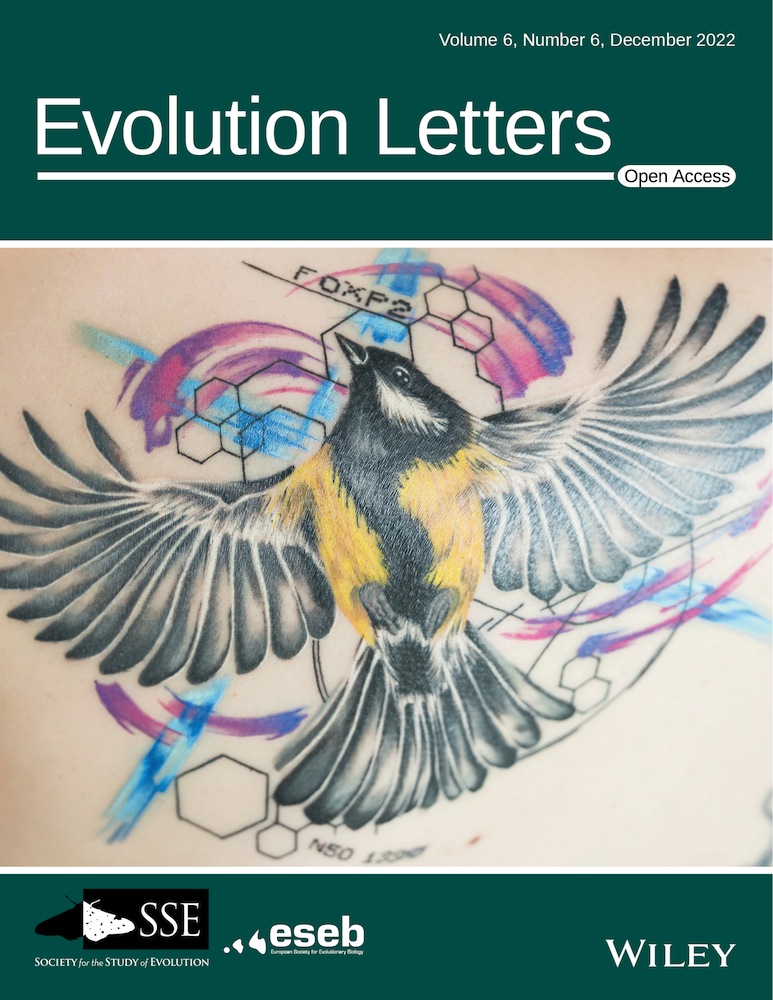Plasticity and the adaptive evolution of switchlike reaction norms under environmental change
IF 3.4
1区 生物学
Q2 EVOLUTIONARY BIOLOGY
引用次数: 0
Abstract
Abstract Phenotypic plasticity is often posited as an avenue for adaptation to environmental change, whereby environmental influences on phenotypes could shift trait expression toward new optimal values. Conversely, plastic trait expression may inhibit adaptation to environmental change by reducing selective pressure on ill-adapted traits. While plastic responses are often assumed to be linear, nonlinear phenotype–environment relationships are common, especially in thermally sensitive traits. Here we examine nonlinear plasticity in a trait with great ecological and evolutionary significance: sexual phenotype in species with environmental sex determination (ESD). In species with ESD, development switches between male and female at an environmental threshold (the inflection point). The inflection point is a key trait for adaptive responses to changing environments and should evolve toward the new optimum in order to maintain evolutionarily stable sex ratios. We used an individual-based theoretical model to investigate how two forms of plasticity in the ESD reaction norm—the nonlinear slope of the reaction norm and a linear shift in the inflection point—influence the evolution of the inflection point under climate warming. We found that steeper reaction norm slopes (high nonlinear plasticity) promoted evolution toward new optimal phenotypes (higher inflection points). In contrast, increased linear plasticity in the inflection point (shift) hindered adaptive evolution. Additionally, populations in moderate warming scenarios showed greater adaptive evolution of the inflection point compared with populations in extreme warming scenarios, suggesting that the proximity of existing phenotypes to new optimal phenotypes influences evolutionary outcomes. Unexpectedly, we found greater population persistence under high climate variability, due to the increased production of rare-sex individuals in unusually cold years. Our results demonstrate that different forms of phenotypic plasticity have crucially different effects on adaptive evolution. Plasticity that prevented sex ratio bias hindered the evolution of the inflection point, while plasticity that exacerbated sex ratio bias promoted adaptation to environmental change.环境变化下开关反应规范的可塑性与适应性演化
表型可塑性通常被认为是适应环境变化的途径,因此环境对表型的影响可以将性状表达转向新的最优值。相反,可塑性性状表达可能通过减少对不适应性状的选择压力而抑制对环境变化的适应。虽然塑性反应通常被认为是线性的,但非线性表型-环境关系是常见的,特别是在热敏性状中。在这里,我们研究了具有重要生态和进化意义的性状的非线性可塑性:具有环境性别决定(ESD)的物种的性表型。在具有ESD的物种中,雄性和雌性的发育在一个环境阈值(拐点)之间切换。拐点是对不断变化的环境做出适应性反应的一个关键特征,为了保持进化稳定的性别比例,拐点应该朝着新的最佳状态进化。采用基于个体的理论模型,研究了气候变暖条件下ESD反应范数的两种塑性形式——反应范数的非线性斜率和拐点的线性位移如何影响拐点的演变。我们发现更陡的反应范数斜率(更高的非线性可塑性)促进了向新的最佳表型(更高的拐点)的进化。相反,拐点(移位)线性可塑性的增加阻碍了适应性进化。此外,与极端变暖情景下的种群相比,中等变暖情景下的种群在拐点上表现出更强的适应性进化,这表明现有表型与新的最佳表型的接近程度会影响进化结果。出乎意料的是,由于罕见性个体在异常寒冷的年份增加了产量,我们发现在高气候变异性下,种群持久性更强。我们的研究结果表明,不同形式的表型可塑性对适应性进化具有至关重要的不同影响。阻止性别比偏差的可塑性阻碍了拐点的进化,而加剧性别比偏差的可塑性促进了对环境变化的适应。
本文章由计算机程序翻译,如有差异,请以英文原文为准。
求助全文
约1分钟内获得全文
求助全文
来源期刊

Evolution Letters
EVOLUTIONARY BIOLOGY-
CiteScore
13.00
自引率
2.00%
发文量
35
审稿时长
10 weeks
期刊介绍:
Evolution Letters publishes cutting-edge new research in all areas of Evolutionary Biology.
Available exclusively online, and entirely open access, Evolution Letters consists of Letters - original pieces of research which form the bulk of papers - and Comments and Opinion - a forum for highlighting timely new research ideas for the evolutionary community.
 求助内容:
求助内容: 应助结果提醒方式:
应助结果提醒方式:


